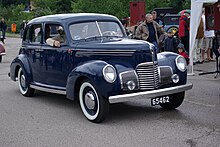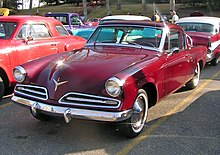Studebaker Champion
The Studebaker Champion was a passenger car manufactured by the Studebaker Corporation in South Bend, Indiana . Production of this model began in the 1939 model year and continued until 1958, when it was discontinued in favor of its successor, Lark . Studebaker had previously had to register a settlement and tried to make production profitable again.
Studebaker urgently needed the success of the Champion in model year 1939 to survive after the weak sales figures of the previous year.
Like few other car models, the Champion was designed on "white paper", which meant that there was no need to continue using older parts or to use the newly designed components later in larger cars. Thorough market observations led to a specification sheet , but the decisive design principle was the premise "Weight is the enemy!". For its size, the Champion was the lightest car of its time; its greatest competitor in this respect was the Willys Americar , which, however, was not subjected to such a carefully considered construction process. And the result was impressive: its tappet-controlled engine was retained until the car production was discontinued in 1961 (but with a modified valve train as OHV ).
The champion was one of Studebaker's greatest sales successes due to its low price (only $ 660 for the 1939 business coupe), its durable machine, and its styling. This styling came from industrial designer Raymond Loewy , whom Studebaker had hired for the construction of their models. The champion won the Mobilgas Economy Run because it had the lowest fuel consumption. During World War II , the Champions were valued because they used very little gasoline during a period of gasoline rationing in the United States. From 1943 to 1945, the Champion's engine was used as a source of power for the unique M29 Weasel crew and load transporter , which also had four Champion leaf spring packages installed transversely.
After the war
In 1946, Studebaker produced a limited number of cars with 1942 bodies before newer design cars left the factory in 1947. All Studebaker models built in 1946 were called Skyway Champion .
A completely new model, also designed by Raymond Loewy , was introduced in 1953. The vehicle has a very flat body that was quite comparable to European sports cars of the time. This model was not only available as a sedan and coupé, but also as a convertible and station wagon.
The last model appeared in 1957. The front with double headlights and a huge radiator grille underneath is reminiscent of the Chevrolet Bel Air of that time. In 1957 Studebaker also introduced the champion Scotsman , a champion with lean equipment, in order to be able to survive against the "Big Three" and Nash in the low-price segment. A short time later, this equipment line was run as the Studebaker Scotsman's own model .
Sources and web links
- James H. Maloney: Studebaker Cars. Crestline Books, 1994, ISBN 0-87938-884-6 .
- Richard Langworth: Studebaker, the Postwar Years. Motorbooks International, 1979, ISBN 0-87938-058-6 .
- John Gunnell (Ed.): The Standard Catalog of American Cars 1946-1975. Kraus Publications, 1987, ISBN 0-87341-096-3 .
- Memories of the interview with Audrey Moore Hodges


